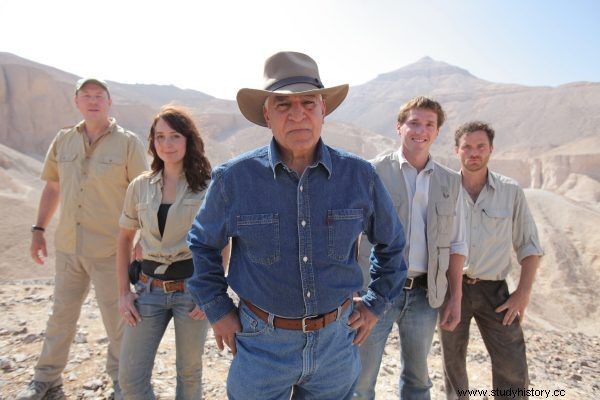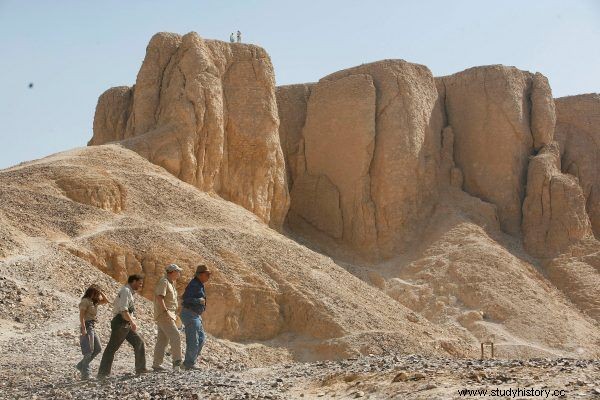The three pyramids against the setting sun are the most recognizable symbols of ancient Egypt. It is impossible to confuse them with anything else. But are you sure you know their history?
Not only tombs
It is well known that the pyramids were the tombs of the pharaohs, but in ancient Egypt the tomb of the ruler was much more than his eternal resting place. Pharaoh from the earliest times was the incarnation of Horus on earth. After death, the god reunited with the earthly heir, and the deceased king reunited with his father, Osiris.
From this divine perspective, the Egyptian pyramids became a temple in honor of the union of the gods Horus-Osiris, and in their center was placed a pyramid - the symbol of the sun. Therefore, the pyramids should not be treated as separate entities, but always considered as much larger temple complexes.

"The story was inspired by the History 2 series" Secrets of Egyptian Tombs ".
Moreover, they should not be considered silent tombs. Life was transferred where the pyramid was created. From the villages of the pyramid builders to the entire infrastructure and special groups of people who service these huge complexes.
The pyramid wasn't built in a day
Before the idea of the pyramid was born in the minds of the Egyptians, the rulers and mighty of the 1st and 2nd Egyptian Dynasties were placed in chamber tombs. These tombs began to be more and more expanded and enclosed, creating mastaba. This term in Arabic means a bench and perfectly reflects the form of the tomb of the magnates of this era. It consisted of the above-ground part resembling the base of a truncated pyramid, where there was an altar in honor of the deceased, and an underground part, consisting of a burial chamber.
Stairway to heaven
During the Third Dynasty, the idea of the deceased king's tomb began to evolve strongly. The Step Pyramid of Saqqara, the tomb of King Djoser, ushered in an entirely new period in Egyptian history.

Before the idea of the pyramid was born in the minds of the Egyptians, the rulers and mighty of the 1st and 2nd Egyptian Dynasties were placed in chamber tombs.
How was it created? The royal architect of Imhotep decided to set up six smaller and smaller mastabs. In this way, he erected a unique structure that reached a height of about 60 meters. However, it should be remembered that the first pyramid was not a free-standing structure! In addition to the central tomb, the complex included temples, courtyards, galleries, altars, and even a dry moat surrounding the whole area.
Tower of Meidum
The next stage in the evolution of the royal tombs was the pyramid in Meidum completed by the pharaoh Snofru. Its construction, although still staggered in its original design, differed significantly from the one described above. It is also the first building entirely covered with veneers.
The structure of the pyramid in Meidum resembles a multi-stage tower. There was a burial chamber inside. The whole was surrounded by a funerary complex consisting of an upper and lower temple, a stele and probably a smaller pyramid.
"The one in the south who comes out shiny"
The next stop on the way to the perfect shape of the Old Kingdom's tomb was also the pyramid erected by the pharaoh Snofru, known today as the broken pyramid. During the 4th Dynasty it was called "Ta-z-south-that-appears-shining." It was built about 50 km from the previous one in Dahshur.
The name "Łamana" owes its characteristic appearance. Its structure has two degrees of inclination of the walls. Interestingly, the pyramid also has two burial chambers and has two entrances. Despite its duality, it was surrounded by one funerary complex.

It is well known that the pyramids were the tombs of the pharaohs, but in ancient Egypt the tomb of the ruler was much more than his eternal resting place.
There are two basic interpretations of the shape of the Broken Pyramid. The first one speaks of a design error. In the original version, the structure would not withstand the tension and crack, which forced the builders to change the angle of the walls. Another theory supports the duality of the structure and assumes that the different angles of the pyramid were intended to emphasize its duality.
Up to three times a piece
However, Snofru did not rest on his laurels and around the 30th year of his reign he began building another tomb. The North Pyramid, also known as the Red Pyramid, is the first surviving "classic" pyramid. What's more, it also seems to be the first to be carefully planned in its design. The Red Pyramid is also part of a larger burial complex.
A classic of the genre - the Pyramids of Giza
And this is how we come to the creation of the most famous and classic pyramids. The tombs in Giza were built for three rulers - Cheops, Chephren and Mykerinos. They are an icon of ancient and modern Egypt. All three were built in the form of a pyramid and covered with veneers. All three are also elements of classic burial complexes.
The most famous of them is built around 2560 BC. Cheops pyramid. It is called the Great Pyramid for a long time and in antiquity it was considered one of the Seven Wonders of the World. It consists of approximately 2,300,000 rock blocks and in its original shape was to be 146.59 meters high. The whole is finished with a veneer of polished limestone.
The Great Pyramid impresses not only with its size. Inside, there are as many as 3 burial chambers, which were built along with the progress of work. The Great Gallery leads to the main burial chamber above which there is an impressive relief structure. Its dimensions are also impressive. It is a corridor 46.63 m long and 8.53 m high, which you enter in the middle of a huge structure straight from the much smaller Ascending Corridor.
However, the complex in Giza is not only three monumental tombs and their temples. There are also the statue of the Sphinx, the tombs of the queens, buried boats, mastabas, builders' quarters, and many other items that are not widely known about.
Bibliography:
- Lehner M., The complete Pyramids. Solving the Ancient Mysteries , London 2001.
- Lipińska J .: In the shadow of the pyramids , Ossolineum, Wrocław-Warsaw-Kraków 2003
